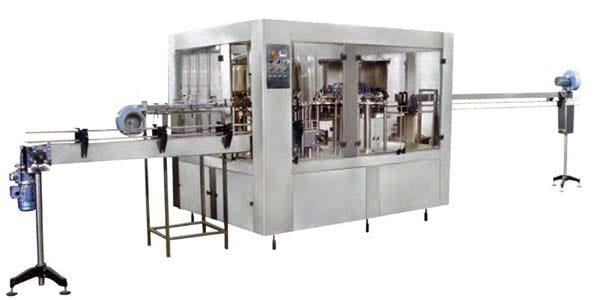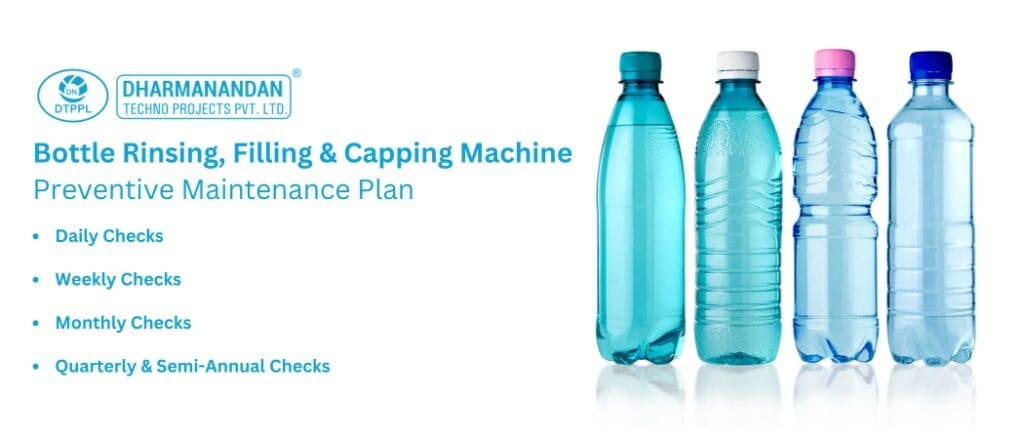
Table of Contents
Preventive Maintenance – Bottle Rinsing, Filling, & Capping Machines
March 21, 2025
Every industry has its heart—its very essence that keeps the wheels of production turning. In the world of bottling, this heart is none other than the fully automatic bottle rinsing, filling, and capping machine. It’s the unsung hero of beverage and liquid packaging, transforming a simple empty bottle into a finished product, ready for the market. These machines work tirelessly, but just like any hero, they need care, attention, and most importantly, preventive maintenance. Without this, they risk breaking down, leading to costly repairs, downtime, and potentially damaging product quality.

Beyond the Fill Line: A Deep Dive into Proactive Care
Imagine the stress and frustration that follows when a machine malfunctions in the middle of a run. The anxiety builds, the pressure increases, and the production line grinds to a halt. This is a nightmare scenario for anyone in the beverage and liquid packaging industry. The fear of losing hours, or even days, of work is palpable. However, the beauty of these machines lies in their resilience, but their resilience is only sustained through one key factor—proactive care.
Preventive maintenance for these fully automatic rinsing, filling, and capping machines isn’t just about routine checks or oil changes. It’s about fostering a deep understanding of how every component, from hydraulics to pneumatics, contributes to flawless production. It’s about addressing potential failures before they become reality, preventing downtime, and ultimately, ensuring the production of high-quality, consistent products.
Historical Hiccups: Learning from the Bottling Line’s Past
In the early days, before we understood the real importance of preventive maintenance, these machines were treated like mere workhorses—fed with energy and fuel, but not truly understood. The result? A laundry list of common challenges that were, in hindsight, all too predictable:
Rinsing Issues: A simple failure in rinsing can lead to contamination. Bottles with residual debris or inconsistent rinsing can cause water spotting and worse—product spoilage. Clogged nozzles, low water pressure, and contaminated rinse water were common culprits, often leading to an unending cycle of production failures.
Filling Inaccuracies: The joy of a perfectly filled bottle is overshadowed by the frustration of underfills, overfills, or product spills. When the valves aren’t in sync, when air bubbles infiltrate the product lines, or when sensors fail, it’s chaos. Every drop counts, and an inaccurate fill can translate into wasted product and costly product recalls.
Capping Problems: Imagine a bottle leaving the line with a loose cap or, worse, no cap at all. The implications are clear—leaking bottles, spoiled products, and compromised tamper-evident seals. These issues often arose from worn capping jaws or misaligned cap feeders, creating a ripple effect across the line.
Bottle Handling Issues: The machine that moves the bottles plays a crucial role. When jams occur, or bottles tip over during transport, production stops. The consequences? Wasted time, damaged bottles, and a hefty loss in product.
Hygiene and Sanitation Issues: In the food and beverage industry, hygiene isn’t just a priority—it’s a necessity. Stagnant water or poor sanitation practices created contamination risks that no one could afford. Bacteria and mold, thriving in neglected components, posed a grave threat to product safety.
It wasn’t until we started digging deeper, analyzing these recurring problems, and addressing them head-on, that we began to understand how to prevent these issues from spiraling out of control.

Building a Predictive Powerhouse: Data-Driven Maintenance
Data isn’t just for tracking trends or analyzing performance—it’s a weapon in the battle against machine failure. The ability to predict failures before they happen is the ultimate advantage, and it all starts with continuous data acquisition. Let’s look at how this unfolds:
Continuous Monitoring: Sensors embedded in every corner of the machine gather real-time data on key parameters. For the rinsing system, this means monitoring water pressure, flow rate, and temperature. For the filling system, it’s all about level sensors, fill times, and pressure. Every bottle, every cap, every pump—monitored, analyzed, and adjusted in real-time.
Regular Inspections: Just because data suggests everything is running smoothly doesn’t mean visual inspections can be skipped. These are your eyes on the ground, finding issues that sensors alone might miss. Whether it’s inspecting fill valves or checking the rinse nozzles for clogs, this human touch is irreplaceable.
Data Analysis and Trending: With time, patterns emerge. A slight increase in fill time might signal a worn-out valve. A sudden fluctuation in cap application torque can indicate issues with the capping system. By using trend analysis and statistical process control (SPC), teams can anticipate when these deviations are nearing critical thresholds.
Automated Alerts: Technology has advanced to the point where machine operators don’t have to wait for failure. Instead, automated alerts can notify them the moment a parameter exceeds its ideal range. This proactive approach enables timely interventions, minimizing downtime and preventing significant issues from arising.
The Preventive Maintenance Plan: Your Detailed Action Plan
The key to ensuring machine longevity and smooth operation lies in a solid, well-executed preventive maintenance plan. This isn’t just a checklist; it’s a living document, evolving as you learn more about the nuances of your specific system. Let’s break it down:
Daily Checks: Every day, operators need to inspect and ensure that no leaks, unusual noises, or vibrations are present. Simple yet crucial tasks like checking the rinsing system’s water pressure, inspecting the filling valves, and ensuring smooth bottle movement are fundamental to keeping the machine in optimal shape.
Weekly Checks: These are your deep dives. Cleaning rinse nozzles, inspecting capping heads, and checking conveyor belts for wear are all essential tasks that can catch potential problems before they escalate. Regular lubrication ensures smooth functioning, while filter cleaning or replacement keeps everything flowing efficiently.
Monthly Checks: Every month, more intensive inspections are necessary. Calibration of filling valves, checking capping torque, and performing a thorough inspection of electrical connections are some of the tasks that fall into this category. These checks are the safety net that catches problems before they manifest on the line.
Quarterly and Semi-Annual Checks: This is where you get into the major overhauls—deep cleaning, component inspections, and the replacement of wear parts. It’s during these checks that the most significant issues can be addressed before they have a chance to impact production.

Executing the Plan: How-To Guides for Key Tasks
Performing a maintenance check isn’t always straightforward. For instance, when it comes to cleaning the rinsing nozzles or inspecting the filling valves, there’s a clear process to follow. It requires careful disassembly, proper cleaning, and meticulous reassembly. Every small detail counts, as a single misstep could cause the entire system to malfunction.
Embracing Predictive Technologies: The Future of Bottling Maintenance
The future of preventive maintenance lies in the integration of advanced technologies. IoT sensors and connectivity allow for real-time remote monitoring, enabling operators to make adjustments from anywhere in the world. Cloud-based platforms store and analyze the data, providing insights that were once out of reach. Machine learning and augmented reality are also revolutionizing the way we approach maintenance, making processes more intuitive and efficient than ever before.
Fully Automatic Bottle Rinsing Filling and Capping Machine
Capacity: 30 BPM to 500 BPM
(USD 9,000 to USD 1,96,000)
Conclusion: The Pursuit of Bottling Perfection
The journey of a bottling line is one of continuous improvement. As we embrace data-driven maintenance and predictive technologies, we unlock new levels of efficiency, safety, and quality. A well-maintained rinsing, filling, and capping machine doesn’t just keep the production line running—it ensures that every bottle that leaves the line is perfect. Every day, we strive for bottling perfection, and preventive maintenance is the key to achieving this goal.
By implementing a robust preventive maintenance plan, you’re not just safeguarding your machines; you’re investing in the future of your bottling operation. The peace of mind that comes with knowing your machines are in top shape is invaluable. And as you continue to refine and execute your maintenance strategy, the results will speak for themselves: smoother operations, fewer breakdowns, and most importantly, happy customers.
At DTPPL, we’re committed to ensuring your bottling systems operate flawlessly, every time. Reach out today to explore how our advanced solutions can keep your bottling line running at its best, with minimal downtime and maximum efficiency.
About Author

Director – Global Marketing and Sales
Mr. Bhavesh from Dharmanandan Techno Projects Pvt. Ltd. has played a pivotal role in elevating the DTPPL brand to the global stage, leveraging his exceptional expertise in marketing and communications. He is committed to helping clients achieve significant growth while strengthening their own brands. Dharmanandan Techno Projects Pvt. Ltd. is a leading manufacturer and supplier of water purification systems and turnkey solutions for mineral water plants. With years of experience in designing and delivering high-quality water treatment solutions, the company provides end-to-end services, including system design, installation, maintenance, and ongoing support. Specializing in scalable and customizable water plants, DTPPL has successfully served industries worldwide, ensuring clean and safe drinking water across diverse applications.





